|
January 1972 Popular Electronics
 Table of Contents
Table of Contents
Wax nostalgic about and learn from the history of early electronics. See articles
from
Popular Electronics,
published October 1954 - April 1985. All copyrights are hereby acknowledged.
|
According to this 1972
article in Popular Electronics magazine, cable television began around
1950. The system was very different that what we have nearly 70 years later. The
familiar acronym CATV does not stand for CAble TeleVision, but rather Community
Access TeleVision. CATV, as originally implemented, was a means of bringing broadcast
TV to areas either too remote or too shielded from over-the-air (OTA) RF signals
to provide good signal reception. Depending on the need, CATV could range from re-broadcasting
of signals into targeted areas or sending signals through cable (originally unshielded)
to individual homes. As you might expect, opponents of the new system predicted
that such a scheme would eventually be the kiss of death for local broadcasters
since large, well-funded conglomerates would be able to dominate programming selection
and dry up advertising revenue from local businesses that could support local stations.
History now shows that not only did the local stations survive cable networks, but
the recent "cord
cutting" phenomenon is actually causing a reverting back to OTA reception by
homeowners (like moi), thus helping to ensure a long life for local stations.
Cable TV - Where It Is & Where It's Going

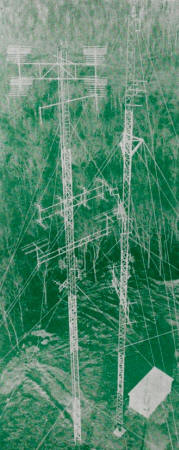
Towers bristling with TV antennas, such as these at a Jerrold
system in Harrisburg, Pa., were main source of signals for CATV. Now, operators
originate signals of their own.
The winding road to Cable TV may lead to more and better viewing.
By Forest H. Belt
Cable television is an enigma. The further it goes, the harder it is to tell
just where it is going. When it was simply community antenna TV (CATV), it provided
the simple, basic service of bringing TV reception to those areas that broadcast
stations could not reach. But 22 years have brought about changes. Purposes and
outlook have changed - not to mention the name.
Today's cable TV is a system for delivering many channels of TV to home receivers
by wire (coaxial cable). Some channels deliver nearby station programs that you
would receive anyway. Others carry signals imported from distant stations, picked
up by powerful antennas and relayed by microwave. At least one channel can carry
programs generated by the cable owner (often including commercial advertising).
This is no longer a simple multi-customer antenna service. It is cablecasting. The
term "CATV" belongs to a bygone era.
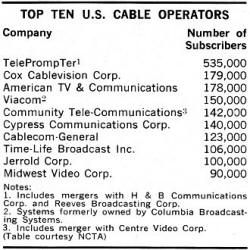 By the Numbers. You can gauge the
significance of cable TV by the way it has grown. In spite of powerful and determined
opposition, its proliferation has been fast and steady over the past six years. By the Numbers. You can gauge the
significance of cable TV by the way it has grown. In spite of powerful and determined
opposition, its proliferation has been fast and steady over the past six years.
More than 2500 cable TV systems presently serve 4.6 million homes in some 4300
communities. Roughly 15 million, or about 7 percent, of the nation's viewers daily
watch cable-delivered TV. For this service they pay $4.50-$6.00 monthly - an annual
gross revenue for cable owners approaching $300 million.
But is cable TV profitable? Look at it this way: Monthly operating costs seldom
exceed $2.50 per subscriber. Before-tax operating profits run 50 percent or better.
Investment stands at about $600 million. and the return on that investment usually
is about 20 percent. With figures like these, cable TV attracts plenty of capital.
The cable TV concept is a mover. One reasonable estimate anticipates that half
the country (30 million homes) will be on cable by 1980. At least 7500 systems will
he needed to serve the communities involved, and cable owners will invest about
$5 billion in facilities. Annual revenues could exceed $3 billion. Commercial broadcast
TV grosses about this amount from advertising right now.
The whole country will eventually require as many as 15,000 cable systems feeding
into 60 million homes and, says one analyst, 20 million businesses. By that time,
however, the character of cable TV will have changed again, and a new term will
outmode "cablecasting."
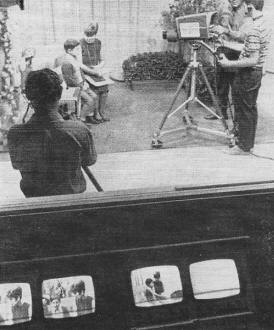
Cable operators now generate their own live programs on one channel.
This TeleMation-equipped studio cablecasts black and white.
Ups & Downs. Cable TV takes new turns every month. Last
summer, cable owners began putting their own programs on one channel. The programs
are limited mostly to live community news and sports and to old movies. Few are
in color. But the effort is there.
(The Federal Communications Commission tried to mandate original programming
on at least one cable channel. But Midwest Video Corp. appealed the order and a
US Court of Appeals ruled that cable owners are not required to originate their
own programs. But other FCC dictums keep altering the industry's direction.)
Telephone companies own 20 percent of the cable systems. According to the FCC,
they cannot operate both telephone service and cable TV. Hence. they have just three
years to dispose of their systems.
Networks are now forbidden to own cable systems. Nor can a station operate a
cable system within its own coverage area. Consequently, CBS has made a separate
firm of its cable companies. (ABC and NBC have no cable interests to sell off.)
If the FCC has its way, the networks will not be permitted to produce programs
for either over-the-air or by wire syndication. This limits the sources of programs
for the cable owner. It also precludes networks from eventually feeding cable TV
systems. But this particular obstacle may not prevail.
New systems are not coming into being as often as they did before. One reason
is that cities hesitate to grant franchises. The question of jurisdiction is not
resolved. Whether cable franchising should be controlled by the FCC or handled by
city or state utility commissions is still up in the air.
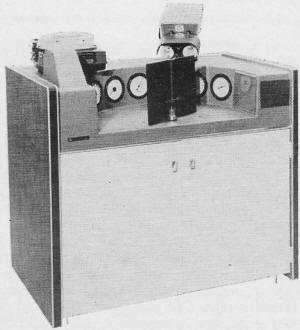
Weather scanner complete with gauges used by some cablecasters.
The scanning mirror reflects readings on gauges and card announcements to camera
above. Music is sometimes also transmitted on this same channel.
The FCC may decide to issue licenses to cable owners as they do with broadcasting
stations, allowing the cities a small franchising fee. The few states that do regulate
cable TV take varied approaches. So, for the sake of national uniformity it appears
that the FCC will have to do the regulating.
A ban already exists against importing signals into the top 100 TV markets. Some
people think that importation is unfair to local stations and advertisers. The FCC
proposes reducing the ban to only the top 50 markets. Commercials would be deleted
and local ads inserted in their places. The idea, however, is technically impractical,
necessitating the need for some other solution.
The ban has not been ironclad. New York City, for example, is being wired for
cable by two companies. The FCC waived the ban, and it may do the same for other
large cities. What happens in New York may provide an answer to one key question:
Can cable TV be profitable in urban areas where stations are already plentiful.
Indications are that it can. About 70.000 subscribers are already signed up in New
York, and some 3000 more apply every month.
Maps of Utopia. One test of cable TV's value is performance.
What can it do for you that is not already being done? Cable proponents make promises
- some for now, others for the long haul. A few are likely to be realized, and a
few are not. Many rely on unproved technology.
Variety of programming sounds like a reasonable solution since modern cable systems
can accommodate 20, 30, even 70 channels. But consider what might go on these channels.
Suppose that 10 channels are used for nearby commercial and educational TV broadcasts.
The cable owner programs one channel with his own originations, provides another
channel for time and weather reports, and leaves a third for local school and club
news and announcements. This puts only 14 channels to use. Let us say that he imports
10 distant TV station signals. Likely some are network and duplicate programs on
local channels. The upshot is that you may not find the variety you were led to
expect, but it is more than you would get without cable TV.
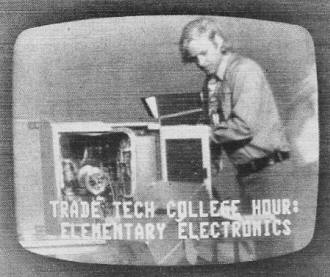
This video display is coded by a special character generator
used by the cablecaster.
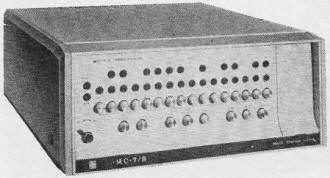
A minicomputer, such as this one, could be hooked into a cable
communications system, and could talk with central computer from "office at home."
Ideas such as this are costly but within the realm of possibility.
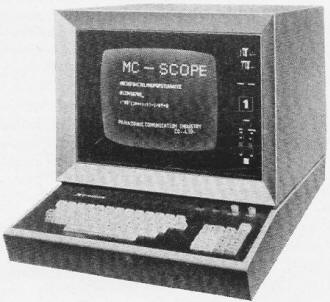
A unit that looks and operates like this Panasonic video-display
computer terminal could take the place of your present TV.
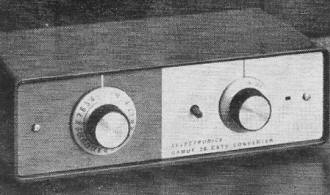
A new Oak 26-channel CATV converter for a conventional TV receiver.
Simple controls include channel-selector switch, fine-tuning control, power switch,
and pilot light.
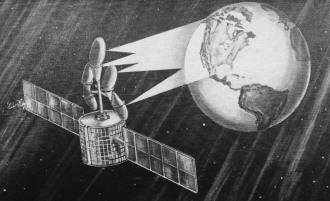
The technology exists now to distribute cable television over
a satellite network to stations on the earth (conveniently located for distribution).
This plan is from a Sylvania system. Economics will determine whether this particular
method will be used.
Quality of programming is another promise. Culture, education, entertainment,
and community improvement all sound nice in a proposed package. All are technically
possible, too. But where to get the financing, producers, directors, talent, and
technicians to make the venture a success is the big problem.
It is folly to believe that cable TV can provide more reliable programming than
has commercial TV, even granting that it will try harder. Nor will it do to attract
the talent away from broadcast TV. This will only dry up those imported and local
channels.
Hometown talent provides a possible out. But mediocrity in today's network attempts
draws enough fire. Local productions tend to be even less professional.
If you envision an end to commercial advertising, forget it. A cable owner sells
advertising for his own channel and often for his weather channel as well. He can
commercialize on his channels that provide only music. Local TV and FM channels
carry whatever commercials accompany their programs. So far, imported channels do
the same; and even if commercials are deleted, local ones will probably be substituted.
Working Both Directions. Just around the corner is two-way cable
TV. It will open a whole new era. With it, you get into true communication by cable.
The term to describe such a system might be cablecom.
From thoughts of nationwide two-way cable TV grow some of the "blue-sky" notions
you hear about. For example, there is subscriber-to-subscriber hookups. It demands
complicated but not impossible switching. Then there are the "office at home"; the
long-awaited home computer terminal; newspapers, magazine articles, books, etc.,
that can be delivered to your home video/copier on demand. None of these is farfetched.
You would perform your own programming by punching the proper buttons to a central
library of stored video and audio tapes. You could transmit and receive letters
on your home copier, although distant ones might go through a post-office-type exchange.
You could even job-hunt and be interviewed by cable TV.
These fantasies are not called blue-sky because they are not possible. They are
possible. It is simply that they are more expensive than you can now afford. Cable
owners agree to add services such as these "as technology permits and subscribers
demand" them. This is a polite way of saying that, when the majority of subscribers
can afford it, they will get a particular service.
Some two-way transmissions would be truly worth their cost. Special cable-com
channels allocated to hospitals, doctors, and medical schools would speed and simplify
information exchanges, consultations, and studies. Home receivers would not pick
up these channels unless at-home care were needed. Law-enforcement agencies would
have like facilities. Home and business security alarms could instantly and directly
alert police, fire, and protection agencies of anything that might go wrong while
you were away.
Japan Broadcasting Co. runs a high school at home by one-way TV. Just imagine
how much more effective the learning process could be if the system were two-way.
Why, even earning a college degree through TV is far from impractical.
Outlook with Cable. How will cable TV affect you? For one thing,
it will take more out of your pocket. "Free TV" costs your family $50 a year in
higher prices for the advertised products you buy. For cable service, you pay about
$60 a year. You get more programs, but they are still accompanied by commercials.
The result is that cable TV will mean an add-on cost to you; the cost of the products
you buy plus your subscriber fee.
You will not be affected much by how cable TV operates electronically, but you
may be interested just the same. Dial-a-program systems are being tried here (similar
to the one in Great Britain). The receiver has no tuner, just a phone-type dial.
Numbers of the program channel are dialed in and pulses cause a central exchange
to hook the cable to one of perhaps 70 program channels. Interconnected countrywide,
these systems might well form the basis for home-to-home cable communications.
A satellite or two could distribute cable TV for the whole country. Proposals
for the grand plan are already in the works. Intelsat-type satellites carry a dozen
or more TV channels. New digital techniques for transmitting color TV signals can
double this figure by taking less spectrum space. And two dozen channels should
be enough for nationwide network coverage.
Microwave is already being used for regional networking. Infrared and laser beams
are being studied as another universal possibility for broadband communications
like cable. And one company is experimenting with microwave delivery directly to
the home.
The pictures you view from cable could look better than those of today. Finer
definition and smoother, truer color are possible. A cable system can decode the
TV signals it receives by present standards and revamp them to much higher standards.
Imaginative cable operators may grab at an opportunity like this.
Top Ten U.S. Cable Operators
The existing cable TV system leaves much to be desired on the technical side.
But you would need a new kind of TV receiver for the things that can be done and
are not far away. Do not look for any great changes to be made right away. When
they come, they will be costly for the subscriber as well as the cable company and
so will come in gradually.
Posted July 22, 2024
(updated from original post
on 11/13/2018)
|


















